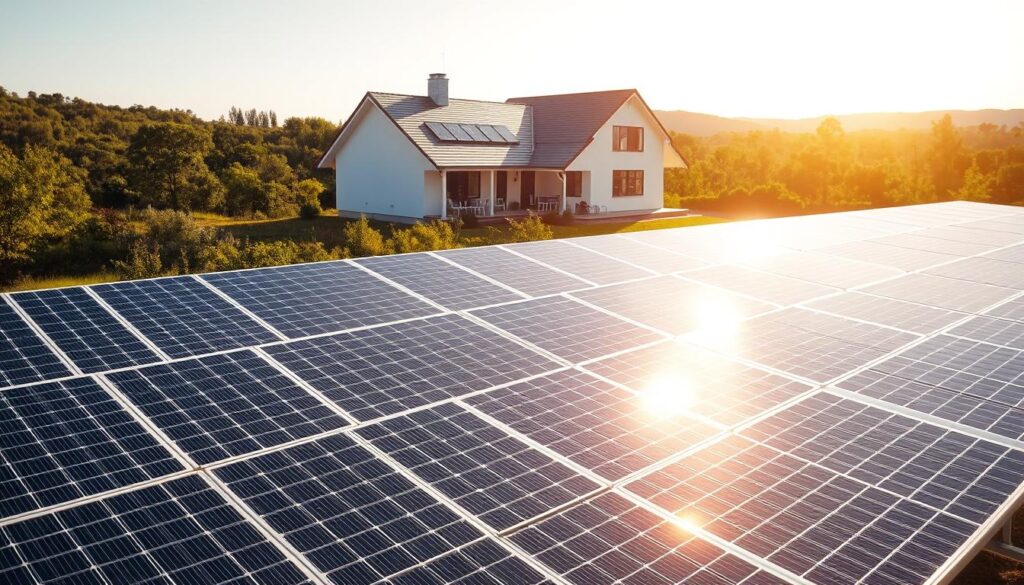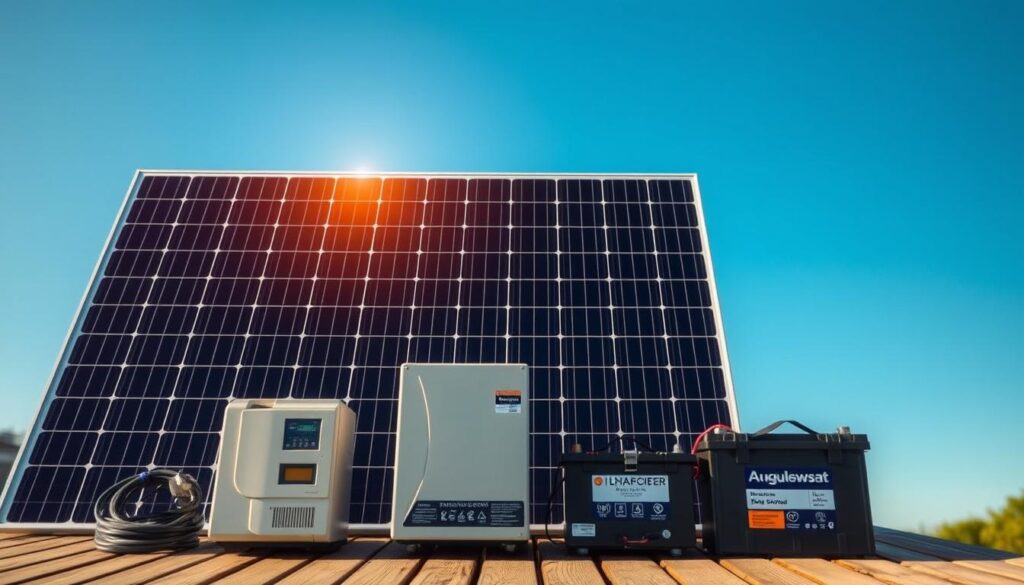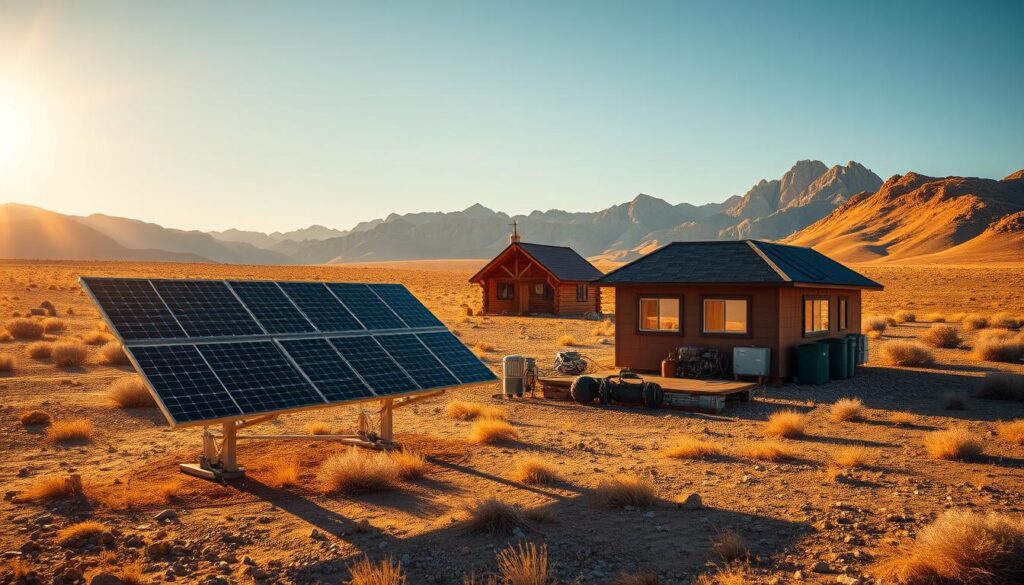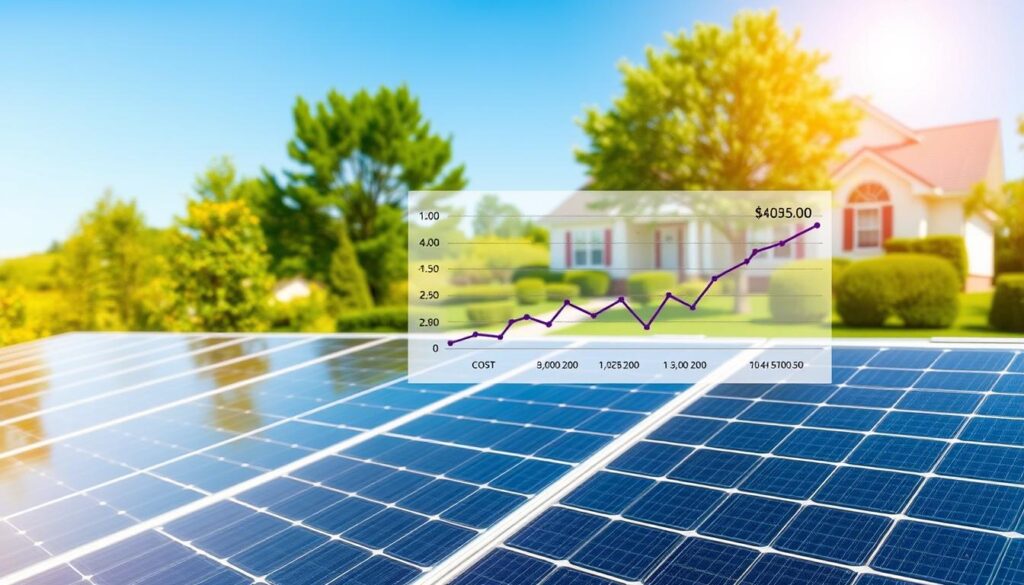Over the past decade, the U.S. has seen a significant rise in the adoption of renewable energy solutions. Supported by initiatives from the U.S. Department of Energy’s Solar Energy Technologies Office (SETO), solar power has become a popular choice for homeowners looking to reduce their energy bills and achieve energy independence.
A typical solar panel system includes panels, inverters, and sometimes battery storage. These components work together to convert sunlight into usable electricity. Whether you choose a grid-tied or off-grid setup, the benefits are clear: lower utility costs and a smaller carbon footprint.
With advancements in technology and decreasing costs, now is the perfect time to consider a solar project for your property. This guide will help you understand the options available and provide insights into installation and long-term savings.
Key Takeaways
- Solar energy reduces utility bills and promotes energy independence.
- Government initiatives have made solar power more affordable.
- A solar panel system includes panels, inverters, and optional battery storage.
- Grid-tied and off-grid systems offer flexibility based on your needs.
- Solar power is an environmentally friendly energy solution.
Introduction to Solar Energy for Modern American Homes
American households are increasingly turning to clean energy solutions to power their lives. This shift is driven by the desire to reduce utility bills and embrace environmentally friendly options. Among these, solar power stands out as a reliable and cost-effective choice.
The Rise of Solar Projects Across the U.S.
In recent years, the U.S. has seen a significant increase in solar installations. From urban rooftops to rural landscapes, solar panels are becoming a common sight. This growth is fueled by advancements in technology and decreasing costs, making it easier for homeowners to adopt this renewable energy source.
Government incentives and industry initiatives have played a crucial role in this expansion. Programs like the Solar Investment Tax Credit (ITC) have made it more affordable for families to invest in solar solutions. As a result, more Americans are enjoying the benefits of lower energy bills and a reduced carbon footprint.
Government and Industry Initiatives Driving Adoption
Both federal and state governments are actively supporting the transition to renewable energy. The Department of Energy’s Solar Energy Technologies Office (SETO) is at the forefront, funding research and development to improve solar technologies. These efforts aim to make solar power accessible to all, regardless of location or income level.
Industry leaders are also stepping up, offering innovative products and services. From grid-tied systems to off-grid options, there’s a solution for every need. Companies are focusing on improving efficiency and durability, ensuring that solar panels deliver long-term value.
By choosing solar, homeowners not only save money but also contribute to a cleaner, more sustainable future. The combination of government support and industry innovation makes now the perfect time to explore solar energy for your property.
Why Choose a Home Solar System for Your Energy Needs
Switching to renewable energy has never been more accessible or beneficial for homeowners. With rising utility costs and a growing focus on sustainability, adopting a solar panel system offers both financial and environmental advantages. Let’s explore why this solution is worth considering.

Cost Savings and Environmental Benefits
One of the most compelling reasons to invest in a solar panel system is the significant reduction in monthly utility bills. On average, homeowners can save 50-80% on their electricity costs. Over time, these savings can add up to tens of thousands of dollars.
Beyond financial benefits, solar energy is a clean, renewable resource. By generating your own power, you reduce reliance on fossil fuels and lower your carbon footprint. This contributes to a healthier planet for future generations.
Real-life examples show the impact. For instance, a family in California reduced their annual energy bill by $1,500 after installing panels. With community solar programs, even renters can save 5-20% on their electricity costs.
Achieving Long-Term Energy Independence
Investing in a solar panel system also provides long-term energy independence. With battery storage, you can store excess energy for use during outages or at night. This ensures a reliable power supply, even when the grid is down.
Financing options and tax credits make the transition easier. The federal tax credit currently covers 30% of installation costs, reducing the upfront investment. Additionally, solar panels can increase your property value by up to 4%, making it a smart financial move.
Here’s a quick comparison of upfront costs versus long-term savings:
| Aspect | Upfront Cost | Long-Term Savings |
|---|---|---|
| Installation | $15,000 – $30,000 | $31,000 – $100,000 over 25 years |
| Tax Credits | 30% reduction | N/A |
| Property Value | N/A | Up to 4% increase |
By choosing solar, you’re not just saving money—you’re investing in a sustainable future. With government support and innovative solutions, now is the perfect time to make the switch.
Top Solar Panel Systems and DIY Solar Kits Product Roundup
The market for renewable energy solutions is booming, offering homeowners a variety of options to meet their needs. Whether you’re looking for a grid-tied setup or an off-grid solution, there’s a system tailored to your requirements. Let’s explore the top-rated products and kits available today.
Grid-Tied vs. Off-Grid Options
Grid-tied systems connect to the utility grid, allowing you to sell excess energy back to the company. This setup is ideal for those who want to reduce their energy bills while maintaining a reliable power source. Off-grid systems, on the other hand, operate independently, making them perfect for remote areas or those seeking complete energy independence.
For example, altE Store offers grid-tied kits with battery backup, ensuring uninterrupted power during outages. Unbound Solar provides off-grid solutions that include high-capacity batteries and durable panels. Both options come with warranties, such as 25-year guarantees on components, giving you peace of mind.
Customizable Solutions for Every Home
One of the biggest advantages of modern solar panel systems is their flexibility. DIY kits from companies like altE Store allow you to customize your setup based on your energy needs and budget. These kits include everything from panels and inverters to mounting hardware, making installation straightforward.
Professionally installed systems, while more expensive, offer expert guidance and seamless integration. Brands like Unbound Solar provide tailored solutions, ensuring your system meets your specific requirements. Whether you choose a DIY kit or a professional installation, the key is to find a solution that aligns with your goals.
“The flexibility of solar solutions today means there’s an option for every homeowner, no matter their energy needs or budget.”
Here’s a quick comparison of grid-tied and off-grid systems:
| Aspect | Grid-Tied | Off-Grid |
|---|---|---|
| Connection | Utility grid | Independent |
| Battery Backup | Optional | Required |
| Cost | Lower upfront | Higher upfront |
| Maintenance | Minimal | Moderate |
By understanding the differences and benefits of each option, you can make an informed decision that suits your lifestyle and energy needs. Whether you’re going solar for the first time or upgrading your current setup, the possibilities are endless.
Understanding Key Components of a Solar Power Setup
A reliable solar setup relies on several critical components working together. Each part plays a unique role in converting sunlight into usable electricity. From inverters to batteries, understanding these elements ensures your project runs smoothly and efficiently.

Inverters, Batteries, and Essential Hardware
The inverter is the heart of your setup. It converts the direct current (DC) generated by the panels into alternating current (AC) for your home. There are three main types: string inverters, power optimizers, and microinverters. Each has its benefits, with microinverters being ideal for shaded areas.
Batteries store excess energy for later use, ensuring you have power during outages or at night. Lithium-ion batteries are popular due to their high energy density and long lifespan. However, sealed lead-acid batteries like AGM are cost-effective for off-grid applications.
Balance-of-system components include mounting hardware, wiring, and disconnect switches. These parts ensure your panels are securely installed and safely connected. High-quality hardware is essential for durability and performance.
Efficiency Ratings and Warranty Considerations
Efficiency ratings determine how well your panels and inverters convert sunlight into electricity. Monocrystalline panels, for example, offer higher efficiency than polycrystalline ones. This means they generate more power in less space, making them ideal for smaller roofs.
Warranties are another critical factor. Most panels come with a 25-year performance warranty, ensuring they maintain a certain efficiency level over time. Inverters typically have shorter warranties, around 10-15 years, so it’s worth investing in models with extended coverage.
Here’s a quick comparison of key components:
| Component | Efficiency | Warranty |
|---|---|---|
| Monocrystalline Panels | High | 25 years |
| String Inverters | Moderate | 10-15 years |
| Lithium-Ion Batteries | High | 10 years |
By choosing high-quality components, you maximize energy capture and ensure long-term reliability. Expert recommendations and real-world examples show that careful selection pays off in the long run.
Installation Insights: DIY Projects vs. Professional Services
Deciding between DIY and professional installation for your solar project can be a game-changer. Both options have their pros and cons, and understanding them is key to making the right choice for your energy needs.
Assessing Your Energy Needs and System Requirements
Before diving into installation, evaluate your current and future energy usage. This helps determine the size and type of system you need. For example, a family of four might require a larger setup than a single person.
DIY projects can save on labor costs, which typically account for 20-30% of the total price. However, improper installation can reduce efficiency by 10-20%. Professional services, while more expensive upfront, ensure compliance with local codes and optimal performance.
Optimizing Roof-Mounted vs. Ground-Mounted Installations
The location of your solar panels impacts their efficiency. Roof-mounted systems are popular for urban homes, while ground-mounted options are ideal for rural properties with ample space.
Ground-mounted setups allow for better angle adjustments, maximizing sunlight exposure. Roof-mounted systems, on the other hand, save space but may require structural assessments. Both options have their merits, so choose based on your property’s layout and energy goals.
“Proper planning and permits are essential for a successful solar installation. Skipping these steps can lead to costly mistakes.”
Here’s a quick comparison of DIY and professional installation:
| Aspect | DIY | Professional |
|---|---|---|
| Cost | Lower upfront | Higher upfront |
| Efficiency | Variable | Optimized |
| Compliance | Risk of errors | Guaranteed |
| Warranty | Limited | 10-25 years |
Whether you choose DIY or professional services, proper planning ensures your solar panel setup delivers maximum benefits. Use this guide to make an informed decision and enjoy the rewards of clean, renewable power.
Exploring Off-Grid and Backup Power Solutions
Off-grid solutions are becoming a lifeline for those seeking energy independence. Whether you live in a remote cabin, travel in an RV, or own a tiny home, these systems provide reliable power without relying on traditional grids. With advancements in technology, off-grid setups are more accessible and efficient than ever.

Battery Backup Systems for Continuous Power
One of the key components of off-grid setups is the battery backup system. These batteries store excess energy generated during the day, ensuring you have power at night or during outages. Lithium-ion batteries, like LiFePO4, are popular for their long lifespan and high efficiency.
For example, a family in a remote cabin can use a battery backup to keep lights and appliances running even during winter storms. With proper sizing and maintenance, these systems provide peace of mind and uninterrupted energy.
Perfect Choices for Remote or Unique Installations
Off-grid systems are ideal for locations where traditional grids are unavailable or unreliable. Customizable kits allow you to tailor your setup to meet specific needs. Whether it’s a small cabin or a mobile RV, these systems offer flexibility and independence.
Here’s how to calculate your energy needs:
- List all appliances and their wattage.
- Estimate daily usage in hours.
- Multiply wattage by hours to get daily energy consumption.
By cutting reliance on traditional grids, you gain freedom and reduce your carbon footprint. Off-grid systems are not just a solution—they’re a lifestyle choice for those who value sustainability and independence.
Evaluating Costs, Savings, and Long-Term Value
Understanding the financial aspects of a solar project is essential for making an informed decision. From upfront costs to long-term savings, careful planning ensures you maximize the benefits of renewable energy.

Budgeting and Pricing Considerations
The initial price of a solar panel setup includes panels, inverters, installation, and permits. On average, homeowners spend between $10,000 and $18,000. However, federal tax credits can reduce this cost by 30%, making it more affordable.
Long-term savings are equally important. For example, a family reducing their monthly bill by $105 can save $1,260 annually. Over 25 years, this adds up to $31,500, not accounting for rising energy costs.
Financial Incentives and Tools
Government incentives like the Solar Investment Tax Credit (ITC) make solar energy more accessible. Additionally, tools like kilowatt-hour calculators help estimate your energy production and potential savings.
Here’s a quick comparison of costs and savings:
| Aspect | Upfront Cost | Long-Term Savings |
|---|---|---|
| Installation | $10,000 – $18,000 | $31,500 over 25 years |
| Tax Credits | 30% reduction | N/A |
| Property Value | N/A | Up to 4% increase |
By comparing different pricing options and using available tools, you can make a smart investment in solar power. Proper budgeting ensures sustainable, long-term value for your energy needs.
Conclusion
The shift toward sustainable energy is transforming how we power our daily lives. By adopting solar panels, households can reduce their reliance on traditional grids and enjoy greater independence. This article has highlighted the financial savings, environmental benefits, and flexibility of renewable solutions.
Whether you choose a grid-tied setup or an off-grid system, there’s an option to meet your needs. DIY kits offer affordability, while professional installations ensure optimal performance. Comparing costs, warranties, and installation methods helps you make the best decision for your energy goals.
From reducing your monthly bill to increasing property value, the advantages are clear. Explore options like solar kits or battery backups to maximize your savings. With federal incentives and expert support, now is the perfect time to invest in clean power.
Take the next step toward a sustainable future. Contact experts like Unbound Solar to assess your needs and start your journey today. Together, we can create a brighter, cleaner tomorrow.
